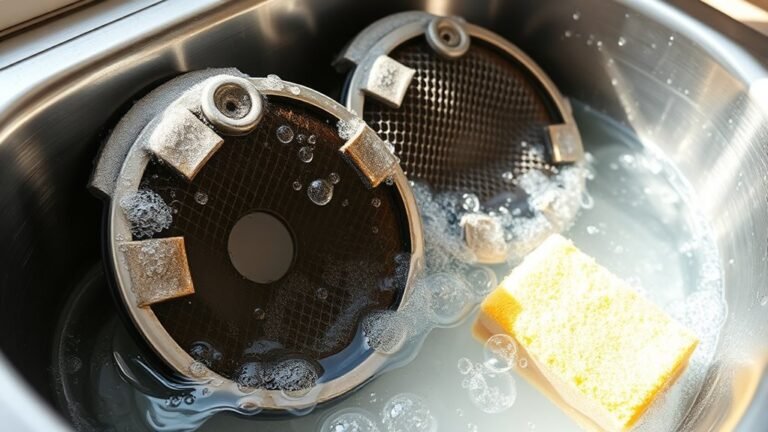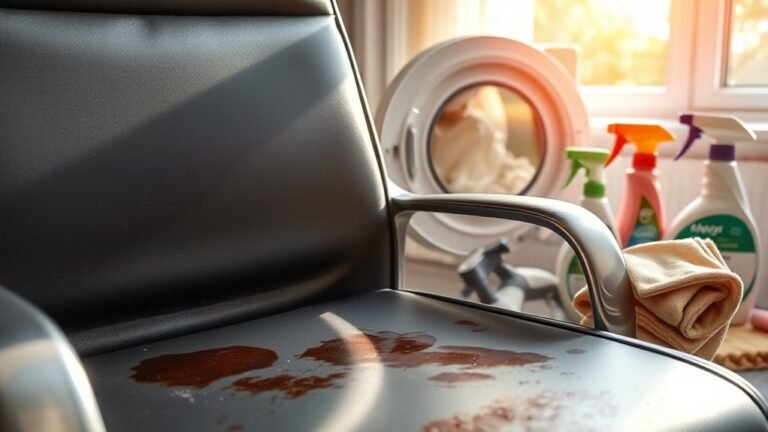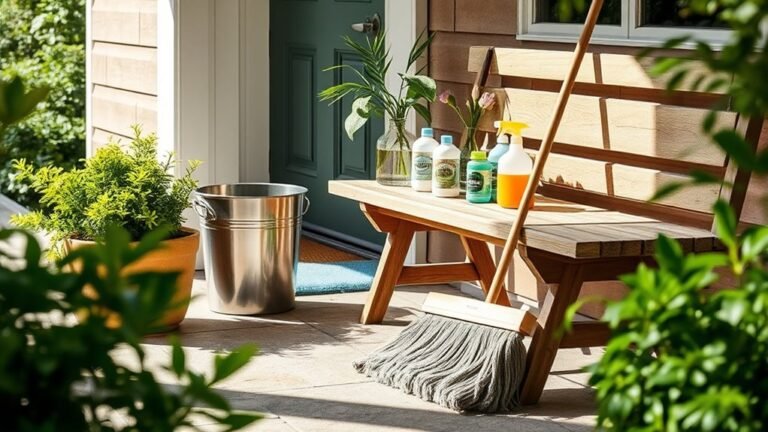How to Remove Pet Hair From Furniture and Carpets
To remove pet hair from furniture and carpets, use a vacuum with a pet hair attachment regularly to capture loose fur. For quick touch-ups, try lint rollers or damp rubber gloves to lift hair efficiently. Dryer sheets can reduce static, making hair easier to remove. Regular grooming of your pet also helps cut down shedding. Keep a consistent cleaning routine, and you’ll find your home stays much cleaner. There’s plenty more to explore for keeping pet hair under control.
Understanding Why Pet Hair Clings to Furniture and Carpets

Although pet hair might seem like just a nuisance, understanding why it clings to your furniture and carpets can help you tackle it more effectively. Pet hair characteristics—like its fine texture and lightweight nature—make it prone to sticking to various surfaces. You’ll notice that certain fabrics and fibers attract hair more, especially those with a rough or porous texture. Static electricity plays a big role, too; it creates a magnetic-like force that pulls pet hair toward your furniture and carpets, making removal tougher. When you grasp these factors, you can better anticipate where hair will gather and address it before it builds up. Knowing this frees you to maintain a cleaner space without feeling trapped by endless pet hair battles.
Best Tools for Removing Pet Hair Effectively
Knowing why pet hair sticks to your furniture and carpets helps you understand what kind of tools will work best to remove it. You’ll want to reach for lint rollers for quick, targeted hair removal. They’re simple, portable, and perfect when you need to freshen up your couch or clothing. For larger areas, vacuum attachments designed specifically for pet hair are a game-changer. These attachments usually have rubber bristles or powerful suction, making it easier to lift hair embedded deep in carpet fibers or fabric. By combining lint rollers for spot cleaning and vacuum attachments for thorough jobs, you can reclaim your space from pet hair without hassle. These tools help you enjoy the freedom of a clean home without endless scrubbing or frustration.
Using Household Items to Lift Pet Hair

You don’t need fancy tools to tackle pet hair—household items can do the job just as well. Dryer sheets help lift hair with their static properties, rubber gloves trap strands when rubbed over surfaces, and a damp sponge can gather hair quickly. Let’s explore how to use these simple tricks effectively.
Dryer Sheets Magic
When pet hair clings stubbornly to your furniture or carpets, dryer sheets can be a surprisingly effective tool to lift it away. Thanks to their ability to reduce static electricity, dryer sheets attract hair without damaging surfaces. Here’s how you can harness this magic:
- Grab a dryer sheet and lightly dampen it with water—this boosts its hair-grabbing power.
- Rub the sheet over the furniture or carpet in one direction to gather pet hair into clumps.
- Collect the hair and toss it in the trash or compost.
Using dryer sheets lets you reclaim your space quickly and easily, freeing your home from stubborn pet hair without harsh chemicals or expensive tools. Give it a try and feel the freedom of clean, hair-free surfaces!
Rubber Gloves Technique
Anyone dealing with pet hair will appreciate the simplicity of using rubber gloves to lift it from furniture and carpets. Just slip on a pair of rubber gloves, slightly dampen them, and run your hands over surfaces. The hair clings to the gloves, making hair removal effortless and freeing you from sticky lint rollers or bulky vacuums. Here’s a quick guide to maximize your rubber gloves technique:
| Step | Action | Tip |
|---|---|---|
| 1 | Wear rubber gloves | Use slightly damp gloves |
| 2 | Glide over surface | Apply gentle pressure |
| 3 | Gather hair | Collect into piles |
| 4 | Rinse gloves | Remove hair easily |
| 5 | Repeat as needed | Great for upholstery |
This simple method gives you freedom from persistent pet hair hassle.
Damp Sponge Method
A damp sponge offers a quick, effective way to lift pet hair from furniture and carpets using items you likely already have at home. The damp sponge effectiveness comes from moisture attraction, which helps gather hair without damaging surfaces or fabrics. Here’s how you can use this method with ease:
- Lightly moisten a clean sponge—avoid soaking, just enough to create slight dampness.
- Gently rub the sponge over the hairy areas; the moisture will attract and lift hair away.
- Rinse the sponge as needed, then wring it out and continue until the surface looks hair-free.
This simple technique gives you freedom from stubborn pet hair using a tool that’s both affordable and eco-friendly. Give it a try next time you want quick, hassle-free cleanup.
Techniques for Removing Hair From Upholstered Furniture

Since pet hair tends to cling tightly to upholstery fibers, you’ll need specific methods to remove it effectively. Start with upholstery cleaning tools like fabric brushes designed to lift hair without damaging fabric. You can also use a vacuum with an upholstery attachment for thorough cleaning. For quick touch-ups, a lint roller or rubber gloves work wonders by grabbing loose hair instantly. Here’s a quick guide:
| Method | Best For |
|---|---|
| Fabric Brushes | Deep embedded hair |
| Vacuum Attachments | Regular maintenance |
| Lint Rollers/Rubber Gloves | Quick, surface cleaning |
Strategies to Clean Pet Hair From Carpets and Rugs
Moving from upholstery to carpets, pet hair can be even trickier to remove because it often embeds deep within the fibers. To free your carpets and rugs from stubborn hair, tailor your approach based on carpet types and master effective vacuuming techniques. Here’s how you can take back control:
- Choose the Right Vacuum: For plush or shaggy carpets, use a vacuum with strong suction and a rotating brush to dislodge hair effectively.
- Vacuum in Multiple Directions: This helps lift hair trapped in different angles of the carpet fibers.
- Use a Rubber Broom or Carpet Rake: These tools attract hair through static charge and can reach deep within fibers where vacuums might miss.
Preventative Measures to Minimize Pet Hair Accumulation
To keep pet hair from piling up, start by sticking to a regular grooming routine for your furry friend. Brushing them often helps catch loose hair before it lands on your furniture and carpets. You can also use protective covers on your furniture to make cleanup easier and protect your upholstery.
Regular Grooming Routine
Although pet hair can seem relentless, establishing a regular grooming routine can greatly reduce the amount you find on your furniture and carpets. You’ll feel more in control and free from constant cleaning battles. Here’s how to get started:
- Choose the right grooming tools for your pet’s coat—brushes, combs, or deshedding tools tailored to their fur type work best.
- Set a consistent grooming schedule, whether daily or several times a week, to catch shedding before it spreads.
- Make grooming a bonding moment; your pet will enjoy the attention, making the process easier and more effective.
Protective Furniture Covers
Since pet hair can quickly embed itself into upholstery, using protective furniture covers is one of the easiest ways to keep your sofas and chairs hair-free. Opt for pet friendly covers designed specifically for furniture protection—they’re durable, easy to remove, and washable. These covers create a barrier that prevents hair from sticking directly to your furniture, saving you time and effort in cleaning. Plus, they let your pets relax comfortably without damaging your favorite spots. Choosing covers in materials like microfiber or canvas offers both style and function, letting you maintain a clean space while embracing the freedom of having pets roam freely. By investing in protective furniture covers, you reduce hair buildup, keeping your home tidy and your furnishings looking fresh with minimal hassle.
Maintaining a Fur-Free Home With Regular Cleaning Routines
Keeping pet hair under control becomes much easier when you stick to a regular cleaning routine. You’ll want to create a cleaning schedule that fits your lifestyle, ensuring you tackle pet hair before it piles up. Use pet friendly products to avoid harsh chemicals that might bother your furry friends.
Here’s how to maintain a fur-free home with ease:
- Vacuum furniture and carpets daily or every other day to capture loose hair.
- Wipe down surfaces with microfiber cloths or pet hair removers.
- Wash pet bedding and blankets weekly to reduce shedding sources.
Frequently Asked Questions
Can Certain Pet Diets Reduce Shedding Significantly?
Ever wish shedding could just vanish like magic? While no diet can stop it completely, certain pet diets rich in omega-3 fatty acids and dietary supplements can dramatically reduce shedding. Combining these with consistent grooming routines gives you more freedom from constant cleanups. By nourishing your pet from the inside out, you’re not just managing hair—you’re boosting their overall health, making life easier for both of you.
How Does Humidity Affect Pet Hair Clinginess?
You’ll notice that when humidity levels drop, static electricity builds up, making pet hair clingier than usual. Low humidity causes static charges to increase, so fur sticks stubbornly to your clothes and surroundings. On the flip side, higher humidity helps reduce this static cling, giving you more freedom from pesky pet hair sticking everywhere. So, keeping your environment a bit more humid can really help lessen that clingy fur problem.
Are There Professional Services Specializing in Pet Hair Removal?
Yes, you’ll find professional services specializing in pet hair removal that go beyond basic cleaning. These experts often combine pet grooming and shedding control techniques to keep your home hair-free and comfy. Hiring them means you don’t have to stress about constant vacuuming or lint rolling, giving you more freedom to enjoy your space without pet hair worries. It’s a great way to maintain a tidy home effortlessly.
Can Pet Hair Cause Allergies or Health Issues?
Ever wondered if that stubborn pet hair lurking around could be more than just a nuisance? It can actually trigger allergy symptoms like sneezing, itchy eyes, or even worsen asthma. You might not realize it, but constant exposure can lead to real health concerns. Don’t let pet hair hold you back—taking steps to manage it helps you breathe easier and enjoy your freedom without those pesky allergy setbacks.
What Fabrics Attract the Least Pet Hair?
If you want to keep pet hair at bay, choosing upholstery made from synthetic fibers is your best bet. These fabrics don’t attract hair as much as natural fibers like wool or cotton, making your space feel cleaner and freer. When picking upholstery choices, look for materials like nylon or polyester—they repel hair and make cleanup easier. This way, you can enjoy your freedom without constant pet hair battles.






